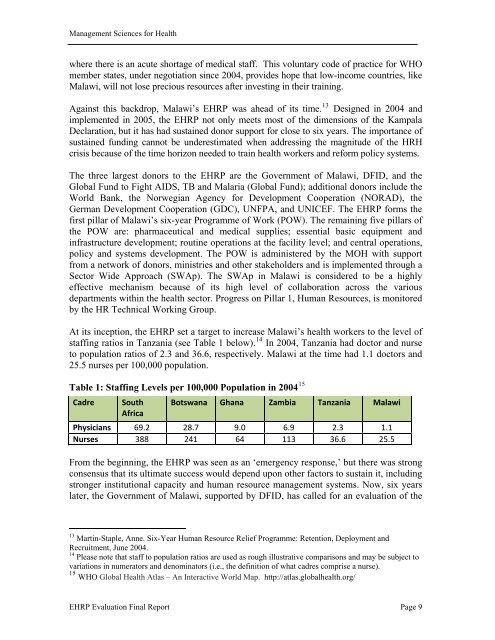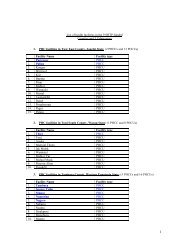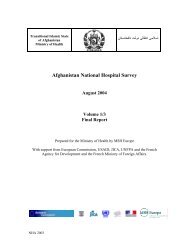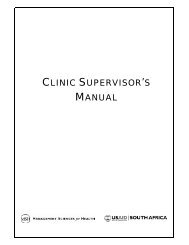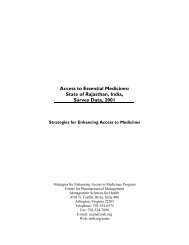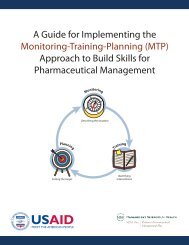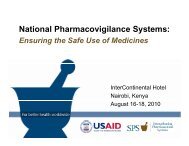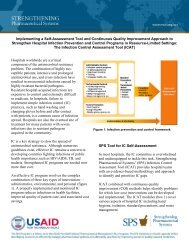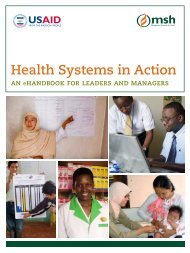Evaluation of Malawi's Emergency Human Resources Programme
Evaluation of Malawi's Emergency Human Resources Programme
Evaluation of Malawi's Emergency Human Resources Programme
Create successful ePaper yourself
Turn your PDF publications into a flip-book with our unique Google optimized e-Paper software.
Management Sciences for Health<br />
where there is an acute shortage <strong>of</strong> medical staff. This voluntary code <strong>of</strong> practice for WHO<br />
member states, under negotiation since 2004, provides hope that low-income countries, like<br />
Malawi, will not lose precious resources after investing in their training.<br />
Against this backdrop, Malawi’s EHRP was ahead <strong>of</strong> its time. 13 Designed in 2004 and<br />
implemented in 2005, the EHRP not only meets most <strong>of</strong> the dimensions <strong>of</strong> the Kampala<br />
Declaration, but it has had sustained donor support for close to six years. The importance <strong>of</strong><br />
sustained funding cannot be underestimated when addressing the magnitude <strong>of</strong> the HRH<br />
crisis because <strong>of</strong> the time horizon needed to train health workers and reform policy systems.<br />
The three largest donors to the EHRP are the Government <strong>of</strong> Malawi, DFID, and the<br />
Global Fund to Fight AIDS, TB and Malaria (Global Fund); additional donors include the<br />
World Bank, the Norwegian Agency for Development Cooperation (NORAD), the<br />
German Development Cooperation (GDC), UNFPA, and UNICEF. The EHRP forms the<br />
first pillar <strong>of</strong> Malawi’s six-year <strong>Programme</strong> <strong>of</strong> Work (POW). The remaining five pillars <strong>of</strong><br />
the POW are: pharmaceutical and medical supplies; essential basic equipment and<br />
infrastructure development; routine operations at the facility level; and central operations,<br />
policy and systems development. The POW is administered by the MOH with support<br />
from a network <strong>of</strong> donors, ministries and other stakeholders and is implemented through a<br />
Sector Wide Approach (SWAp). The SWAp in Malawi is considered to be a highly<br />
effective mechanism because <strong>of</strong> its high level <strong>of</strong> collaboration across the various<br />
departments within the health sector. Progress on Pillar 1, <strong>Human</strong> <strong>Resources</strong>, is monitored<br />
by the HR Technical Working Group.<br />
At its inception, the EHRP set a target to increase Malawi’s health workers to the level <strong>of</strong><br />
staffing ratios in Tanzania (see Table 1 below). 14 In 2004, Tanzania had doctor and nurse<br />
to population ratios <strong>of</strong> 2.3 and 36.6, respectively. Malawi at the time had 1.1 doctors and<br />
25.5 nurses per 100,000 population.<br />
Table 1: Staffing Levels per 100,000 Population in 2004 15<br />
Cadre South<br />
Africa<br />
Botswana Ghana Zambia Tanzania Malawi<br />
Physicians 69.2 28.7 9.0 6.9 2.3 1.1<br />
Nurses 388 241 64 113 36.6 25.5<br />
From the beginning, the EHRP was seen as an ‘emergency response,’ but there was strong<br />
consensus that its ultimate success would depend upon other factors to sustain it, including<br />
stronger institutional capacity and human resource management systems. Now, six years<br />
later, the Government <strong>of</strong> Malawi, supported by DFID, has called for an evaluation <strong>of</strong> the<br />
13<br />
Martin-Staple, Anne. Six-Year <strong>Human</strong> Resource Relief <strong>Programme</strong>: Retention, Deployment and<br />
Recruitment, June 2004.<br />
14<br />
Please note that staff to population ratios are used as rough illustrative comparisons and may be subject to<br />
variations in numerators and denominators (i.e., the definition <strong>of</strong> what cadres comprise a nurse).<br />
15<br />
WHO Global Health Atlas – An Interactive World Map. http://atlas.globalhealth.org/<br />
EHRP <strong>Evaluation</strong> Final Report Page 9


